The main methods of wall decoration are laying ceramic tiles, wallpapering and coloring. Each of them has its own advantages and disadvantages, certain specifics, application and installation technology. You are free to choose anything, as the range is quite wide. Here we will separately talk about the color scheme for wall paint, its capabilities and diversity.
Kohler is called paint, which has a very saturated or contrasting color. It is used to give the desired shade (otherwise - to tint) oil, latex, alkyd, water-dispersion and other paints. Kohler can pass as a finished coating or a coloring additive for individual surface areas.
Just do not forget that the plots should be small. Best of all, the color is applied to concrete, putty, plastered and brick surfaces. Kohler is just a godsend in terms of finishing facades and interiors.
Home tinting is indispensable for people with a rich imagination who need a “complex” shade that cannot be purchased in a store or done with a tinting machine.
The class of "complex" includes colors that are a mixture of different tones, as well as tint colors. For example, corn yellow is a simple color because you can buy it in any store or market. And the color of currant juice is a completely different matter, because here there is a mixture of purple and red. In this regard, it is impossible to buy such paint, so the only way out is to tint it yourself right at home!
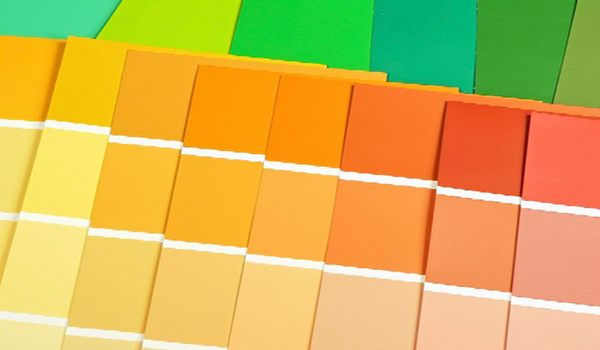
There are two types of colors:
- Colorants are saturated coloring pastes.
- Paints are concentrated intensive solutions.
Advantages of color
The advantages of tinting for home repairs are quite significant, you should definitely pay attention to them:
I will say that modern paints in terms of quality and properties are not at all inferior to other finishing materials.
Important! When applying paint to any surface, you should follow the technology very carefully, otherwise the result may upset you.
Application
The first stage is the preparation of the walls. One way or another, when applying paint to a wall, all its defects are instantly visible: bumps, cracks, etc. To avoid this type, putty should be used.
Then comes the mixing of the paint, which is discussed in detail below. After that, the paint is applied to the surface with a roller. Let's dwell on it in a little more detail.
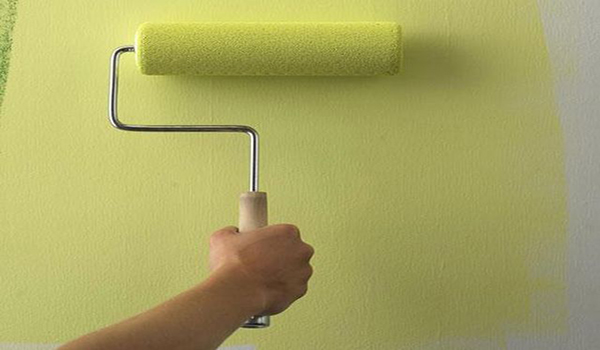
To apply color to the wall, it is necessary to prepare a roller with a fur coat (pile 15-18mm). Due to the fact that some particles will settle to the bottom of the container, do not forget to mix the composition after a certain period. This will give it uniformity and when applied to the wall, the difference between the sections will not be noticeable.
It can be added here that the rolling of the roller plays an important role. This is due to the fact that the thick layer of paint accumulated on the roller does not allow it to be evenly distributed over the wall.
In order for the use of color to give a good result, you should not forget a few more simple rules:
- exclude drafts and direct sunlight;
- make a probe;
- use gloves when working;
- start painting from the wall that is not in plain sight.
A mixture of paint and color must be applied with an overlap - vertical stripes must overlap each other. If the paint is applied to wallpaper that is pasted for painting, please Special attention so that the seams of the wallpaper and the joints of the staining strips do not match.
Don't miss the paint drying time. It is indicated on the package, but usually does not exceed five hours. Thus, if you are painting in two layers, then finishing the room should take one day.
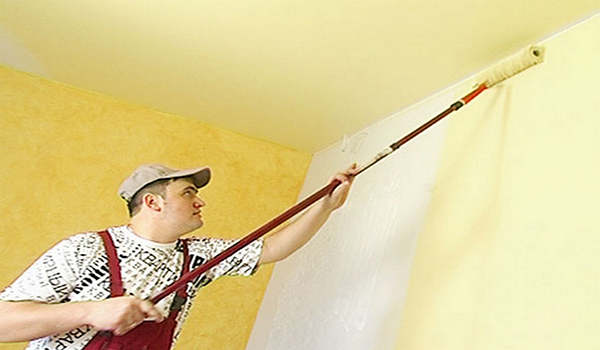
Today, color is both powder and liquid. I can’t say that any of them has more advantages, so you can safely select what you liked more.
Mixing technique
First you need to determine: how much paint do you need? When mixing by hand, there is always a human factor, and ninety-nine percent out of a hundred, that the second time you mix, you will not get the same color as the first. In order to avoid such troubles, be sure to carry out calculations by determining the proportions of the paint. It would be better if there is too much left than to try again to guess the initial shade.
Before applying color to the wall, you need to prepare it. It is important to follow the rules here so as not to make mistakes.
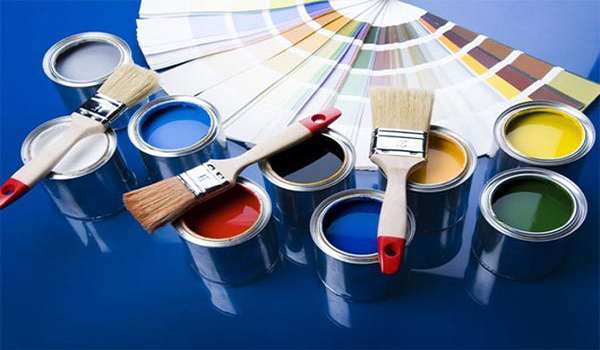
To begin with, you can make a probe that will help determine the desired color and will not spoil the entire volume. This is done as follows: 100 ml of paint is mixed in a small container, then a few drops of pigment are added. You can add it with a syringe, this method will allow you to determine the number of drops and see when the mixture acquires the desired color. When it is reached, write down the number of drops somewhere so as not to keep it in your head.
The next step is to see how the color will look on the wall. It should be borne in mind that on the surface it may be slightly different than in the container. To check, select a small section of the wall and paint with the resulting mixture. Wait until everything is completely dry. Look at it in different lighting conditions, taking as a basis the one that usually prevails in the apartment. If the color matches, you can continue to work.
By the way, this is one of the advantages of painting with color by hand. You can prepare a small amount of paint and save a lot of money.
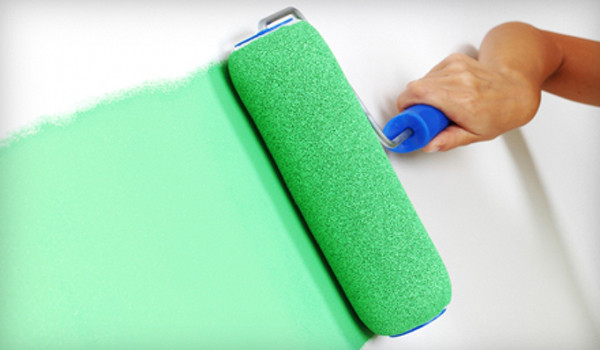
To obtain a significant volume, they take a plastic or enameled bucket. Water-based paint is poured into it, stirred manually or with a construction mixer. Add a little water to get the consistency of "milk". Next, make a color solution. Here we again need calculations.
If, according to the records for the probe, you used 10 drops of one color and 6 of another per 100 ml, then to paint the entire wall, you need to reduce the base by 20%. For 1000 ml, you should take not 100 and 60 drops, respectively, but 80 and 48.
The resulting color solution is added in small portions to a bucket of paint. It is worth applying to the wall in the same way as a probe. In this case, haste is inappropriate. The time spent will surely pay off the result that is pleasing to the eye.
Important! Color must be mixed in one container. Different shades can turn out completely different.
Painting walls with color is not such a complicated process, which this article confirms. The most important thing is to correctly and carefully approach the stages of painting work. Each stage is a special and independent process, which has its own technology. Some little things may seem insignificant, but you should not wave your hand at them. When renovating an apartment, every little thing is needed and important.
The video tells which color is suitable for a certain room in a house or apartment. Helpful Hints provided by construction experts.
Time ready-made solutions when choosing a paint color, they have already passed, and the water-based emulsion, beloved by many, has ceased to be associated only with a white ceiling. The use of colors allows everyone to get the best color solutions by adding and mixing them with white paint. However, in order for the tinting to be successful, it is necessary to choose the optimal color for water-based paint and know how to tint the composition correctly.
Why is it beneficial to use color
They are of organic origin in the form of soot, umber, chromium oxide, ocher. Due to the poor light fastness and ability to fade under the rays of the sun, they are more often used for internal works. And inorganic: they have a more muted color palette, but they are lightfast and fade less.
The use of mother-of-pearl color is very popular. This coloring pigment is perfectly diluted in water-based paint, allows you to get a smooth surface on various textural bases: plaster, wood, drywall, putty.
In addition, it has other equally important advantages:
- affordable cost;
- when using it, special tools are not required;
- ease of use allows you not to involve specialists in the work;
- painted surfaces do not fade even when exposed to direct sunlight.
The choice of colors offered by manufacturers today is extremely diverse.
Color selection rules
To do right choice, it is enough to test the color on the basis of a specialized outlet. Also, modern manufacturers are developing special tables for calculating the amount of color for water-based paint, providing samples of both basic shades and mixed ones, obtained by combining them in equal proportions.
When deciding how to choose the right color for water-based paint, you need to pay attention to such important aspects:
- The desired tone is best selected in the room where the coloring will be performed in order to evaluate it in natural and electric light. In daylight, the paint may appear paler or, conversely, brighter.
- The base, which is to be stained, also matters. The sample offered at the point of sale may have a significant difference in texture from your surface, so there may be a difference between the shades.
- You should also consider what consumption of the tinting composition will be needed per 1 kg of material. This is necessary to acquire the required amount of dye. In the future, the desired color may not be on sale for various reasons, and you will have to do the tinting yourself, choosing a shade, guided by an artistic mixing table of different colors.
- The tinting concentrate should be bought from the same brand, since the same colors from different manufacturers often differ in shade.
- In order for the consumption to be economical and the dosage convenient, it is better to choose a coloring substance in a container with a narrow neck. This will allow you to dilute the color in water-based paint drop by drop, stirring the composition until a uniform color is obtained. If you add a lot of tinting concentrate at once, you may end up with a too saturated color that will spoil the feedstock.
In addition, it is necessary to pay attention to the quality of the coloring base. It should be snow-white in color without impurities, which, when tinted, can interfere with obtaining the desired shade. For example, in the presence of yellowish impurities in the working material, instead of a delicate peach shade, you can get a beige color.
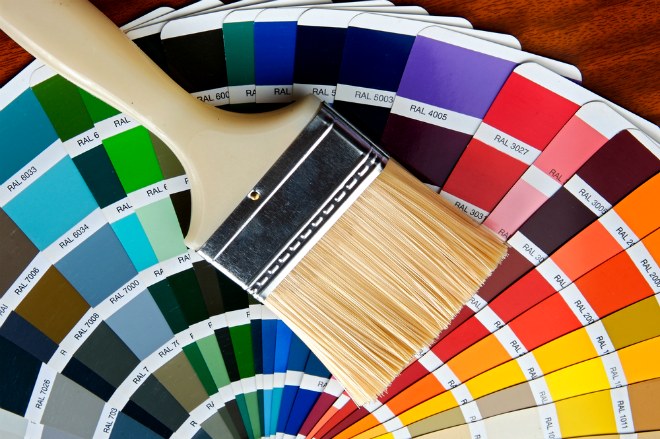
How to tint water-based paint
Tinting of water-based paint is carried out both independently and with the help of a special machine, in which all specified proportions are observed. This service stores offer free of charge, however, the shade created by the machine does not always live up to expectations.
To mix the color, pre-prepare small clean containers, it is better if they are made of glass or plastic. You will also need a construction mixer or a wooden spatula, rags, a substrate made of paper, plastic wrap or thin cardboard.
When tinting paint at home, follow the following sequence of actions:
- pour 100 ml of base material into prepared containers;
- add 5-6 drops of dye, mix well;
- start introducing a couple of drops of other shades, experiment and evaluate the result;
- record in a notebook what color of color and how much was added, this will allow you to calculate the required dye consumption for the tone you like;
- do not forget that the paint that has dried on the surface becomes less saturated and bright.
During the experiment, try the obtained options on the surface and evaluate the result after about 5-6 hours. If everything suits you, you can start tinting the desired volume, focusing on the proportions in your notes.
How to dilute the composition before starting painting work
Pour the right amount of water-based paint into the prepared container. Shake the bottle with the coloring composition well so that it acquires a uniform consistency. Enter the desired shade in predetermined proportions, stir well.
In order for the quality of the composition to be optimal, the dye should be no more than 3% of the total mass of the water-based emulsion, that is, the consumption of color per 10 liters of paint is 300 g.
To achieve the desired effect, test the resulting composition on the working surface, let it dry, examine it in different lighting conditions.
Before painting the surface with tinted paint, mix the mixture thoroughly again, since coloring pigments tend to settle to the bottom.
Fill the remaining color for water-based paint in a bottle with water, so it can retain its original characteristics for 3 years.
Life has ceased to be bland and boring. So you're doing a renovation. The best way show individuality while choose your own shade for walls in an apartment or a facade of a house. With the help of 2-3 multi-colored colors, you can easily cope with the task.
Colors: general characteristics
The term "colour" means color, paint. Its richness and density. The main function of the color is creating the necessary shades when painting brick, concrete, plastered bases.
In the markets building materials a huge number of manufacturers. Both Russian and foreign brands are represented: Dufa (Germany), Tex (Russia), Paritet Décor (France), Unicolor (Russia), Dulax (Dulux, Great Britain). Each company has its own palette of shades.
Kinds
First of all, pay attention to the composition. Colors may contain pigments of organic and inorganic origin. natural pigments give the finished composition brightness of color and saturation. The photo below shows a tint card with a color palette.
These include umber, ocher, soot, burnt sienna, iron minium, chromium oxide. Dyes based on them have low light fastness, fade quickly in the sun. Therefore, they are not recommended for outdoor use.
Pigments of inorganic origin muted colors, at the same time they are more light-resistant, not subject to fading.
Color pearlescent or metallic suitable for most modern paintwork materials.
The next point is the release form. It could be:
- powder;
- paste;
- finished paint.
Do you know what water-based paint consumption per square meter? Read in this article.
Most a budget option- This is a powder color for water-based paint. But it's awkward to use. when mixing, it is difficult to obtain a homogeneous composition. Ready-made water-based paint, such as ivory, is a good solution. There are also such options on the market, the choice of colors is small, 5-6 standard shades.
The most common option is tinting paste. With its help, soft natural colors are obtained. You can add it in portions, until you achieve the desired shade. Keep in mind that color must be less than 20% of the resulting mixture, excess quantity affects the quality of the material.
Color packaging is not of fundamental importance. It all depends on the preference of the manufacturer. It can be tubes, tubes, plastic bottles or bubbles. The material is stored in a dark place at room temperature.
How to choose?
The stores offer a wide range of products. There are several points that help you save money on your purchase and alleviate the problem of choice.
Do not rush to the products of foreign companies. Russian manufacturers have long proved that their colors can withstand competition. The best solution purchase paint and color from one manufacturer.
To search for needed color shades, the table of colors is studied. Mentally play with the hue and saturation of the color.
Pay attention to the packaging. Bottle with a narrow neck will help you count the right amount of drops. This advice is good for small jobs. When painting the facade, you will have to make approximate calculations required amount packages.
How to breed?
Large building materials stores offer a free water-based paint tinting service. The mixing procedure takes place in a special machine, the given proportions are observed very accurately.
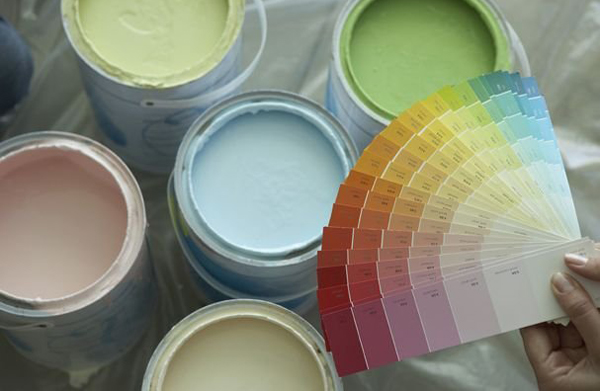
The only negative, when you come home, you suddenly find that shade not as expected.
This can happen for three reasons:
- In the store, you viewed the paint in a different light.
- After drying, the shade became more faded, dull.
- The hue on the wall plane seems brighter than on a small sample in the store.
Therefore, feel free to purchase two or three tones you like and go home to experiment.
Perhaps for you it will useful information how to choose the right paint for outdoor woodwork. Read this one.
Tinting paint at home. Take glass jars or trays from food grade plastic. Rinse containers well.
Pour 100 ml of paint into jars. Add 3-5 drops of color. Stir thoroughly until smooth. Then the most interesting begins. Add other shades drop by drop, mix, evaluate the results.
Only don't forget to write down what shades of color and in what quantity were added. Remember that the color will become less vibrant as it dries.
Apply experimental options to the surface to be painted. After complete drying, approx. after 4-6 hours, evaluate the result. If none of the colors fit, keep experimenting further.
The resulting color suits you - proceed to tinting the volume necessary for coloring. With the help of notes, it will be easy for you to create the desired proportion.
If you do not want to mess with small banks, make calculations and you have an accurate idea of how paints behave when mixed, then immediately proceed to tinting a large amount of water-based paint.
Sequencing:
- Prepare a clean mixing container, a construction mixer or spatula, colors, newspapers instead of a substrate, a cleaning cloth.
- Pour water-based paint into a container in the right amount. Shake the bottle with tinting paste to make the composition homogeneous. Add the desired shade in the given proportions. Mix thoroughly. You can mix with a mixer, a wooden spatula. Some masters make kneading by hand.
- Constantly test the result on the surface to be painted. Examine the sample in daylight and artificial light. The process is tedious, long, but the only way to achieve the desired effect.
- Make sure the color is no more than 3% from the total mass of paint (this is 300 g of color per 10 liters of water emulsion). Otherwise, the quality of the composition will noticeably deteriorate.
- Before the main painting work again mix ingredients thoroughly. Coloring pigments are able to settle to the bottom.
The remaining color can be filled with water and stored until the next repair. In this form the material retains its qualities for three years.
How to tint paint: video tutorial.
Water-based paint is sold exclusively in white.
To make it colored, you need to purchase a color scheme for water-based paint.
By combining different colors, you can make a fantastically beautiful shade.
Kohler for water-based paint is a solution of high concentration, it is used to make the desired color.
They are diluted with the following types of paints:
- water-dispersion;
- latex;
- adhesive.
They are used for interior and facade work. They are available in the form of conventional paint, powder or paste.
Kohler consists of organic and inorganic pigments. Natural pigments are very bright, but not lightfast, therefore, on sunny days, it quickly fades.
Tint colors for water-based paint based on inorganic pigments are not as bright and have a slight color scheme but are very fade resistant.
Picking it up in the store, you need to ask the seller for a special table.
For mixing, you can use a special machine. Usually they are in large stores of building materials.
The necessary ingredients are mixed in them in a strictly specified ratio. These services are most often provided free of charge.
But with such a selection, you can make a mistake with the color, it may not match the required one.
This is due to the fact that the selection was carried out in a different light and on a small sample.
At home, the color may look a little different. Therefore, you can choose several shades from the color palette for water-based paint and mix them at home.
This makes it easier to pick up a complex color, especially if you want to make a solid surface.
Keep in mind that on a large vertical surface, the color will look much richer than on a small sample.
With self-dilution, you can pour a little paint into a shallow dish, add the desired shades of color for water-based paint to it and mix thoroughly.
The color should be a little darker than desired. Add the resulting mixture to the paint and mix with a mixer. Some people find it better to stir by hand.
Make sure that the consumption of color for water-based paint does not exceed twenty percent of it. If you add too much color, the quality may deteriorate.
When choosing colors, see how it will look in daylight, and then turn on the light to see if the color has changed in artificial light.
Instructions for self-tinting
After the choice is made, you can get to work:
- Stock up on small glass jars or plastic food trays in advance. You must wash them properly before use. This is very important when tinting;
- Pour the paint into the prepared jar, be sure to write down its volume. This will come in handy for further mixing. Add a few drops of color to it. If you decide to make a complex color, add two different colors. Start with one to three drops and add carefully drop by drop until you get the color you want. Record the number of drops added;
- To obtain a uniform color, mix the solution well;
- Having received suitable color, you can paint a small section of the wall and check the color in a day when the paint is completely dry. If you like the shade, then tint the remaining paint, observing the desired proportions;
- If the shade does not suit you, then you can increase or decrease the amount of color or add another one. Without experience, it is difficult to choose the right color, but perhaps for this you need to be patient and spare no time.
Market prices
The approximate price of a color scheme for water-based paint is from 20 to 120 rubles per pack.
If you buy more of it and don't use it all up, you can pour water over the pigment in a jar and store it for a long time.
What is the best color to buy for water-based paint? The country of origin does not matter, since domestic pigments are no worse than imported ones, but much cheaper.
Choose pigments in bottles with a narrow neck, it is very convenient to drip and count drops from them.
When choosing, it is better to choose a paste, not a powder. Pasty allows you to quickly achieve the desired shade.
Shake the bottle before use, as many formulations thicken during storage.
You can not use color as an independent coloring agent.
On the this moment manufacturers produce a wide variety of colored paints. However, the range of tones of such coatings is standard, and therefore limited.
Do-it-yourself tinting makes it possible to obtain a composition that has the color, tone and shade that you would like to see in the interior of your home.
Materials for tinting and its methods
The basis of colors are coloring pigments. They are divided into organic and mineral analogues.

Varieties of pigments and colors
- The first type of substances is used to obtain bright shades. However, when it is used on some types of bases, a reaction may begin that will destroy the pigment. In addition, organic compounds burn out from exposure to sunlight.
- Mineral analogues are resistant to weathering, but have a limited range of shades.
Based on pigments, colorants are produced in the form of paints and pastes.
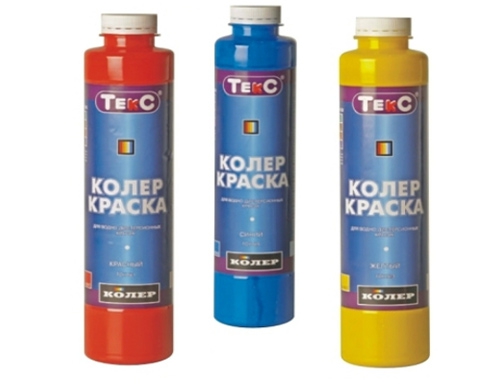
- Coloring paints contain the same components as the main compositions for which they are intended. That is, they can be acrylic, alkyd, oil, etc. By mixing such an additive and a white base paint, you can achieve any desired shade. If a rich color is needed, the base can be painted with an undiluted composition.
- Color pastes contain dispersant resins or are produced without a binder. They can be universal or designed for a specific type of paint. When working with pastes, it is important to keep the proportions, because. an excessive amount of such a color scheme leads to a deterioration in the quality of paintwork materials.
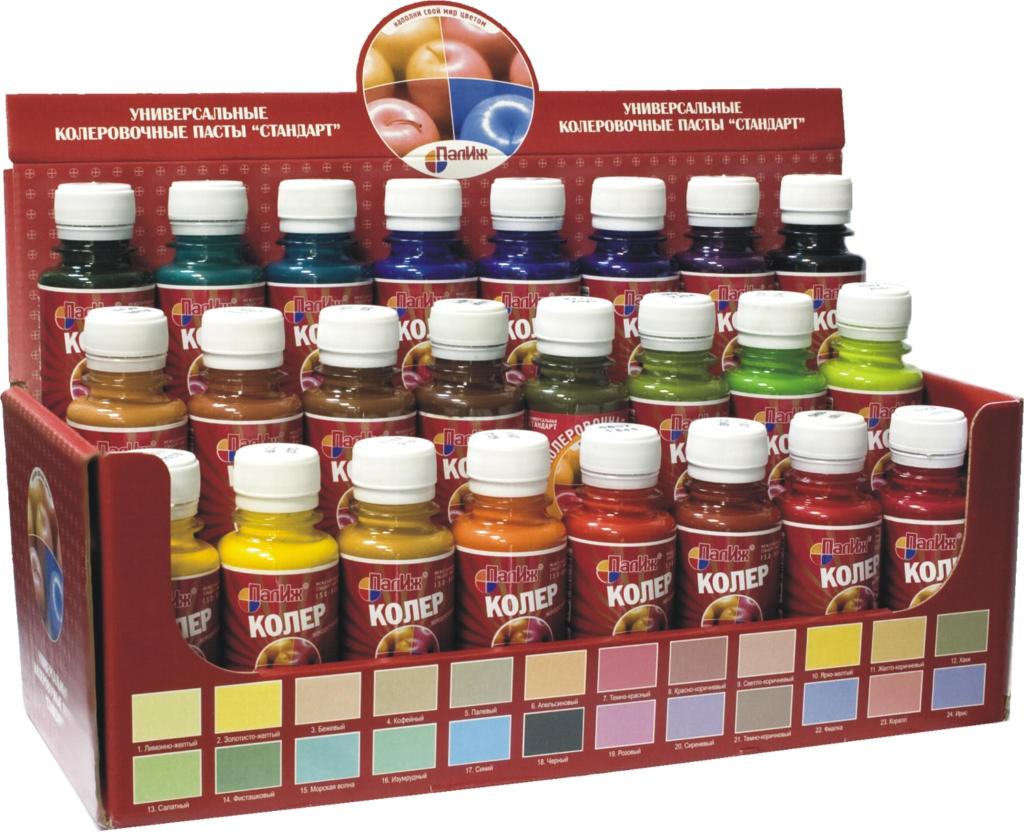
Note! The instruction advises water-based paints add 5/20% color, in oil analogues - no more than 10%. Pastes do not paint compositions well white color. Based on this, special paints are produced that have a reduced content of white pigment.
Important factors to consider
- Experts advise, before tinting paint, to buy a base (usually white) and a color scheme from the same manufacturer.
- It should be borne in mind that if the base and the coloring composition are chosen incorrectly, then the coating will lie unevenly or stains will form on it.
- When mixing paints by hand, it is difficult to maintain proportions and create the same shade several times.
![]()
- Based on this, tinting machines are now most often used. They evenly distribute the dye in the base and ensure the uniformity of its consistency.
- When the base is tinted in dark colors, the percentage of pigments in the paint increases. Therefore, the binder may not be enough to hold all its components together. Manufacturers have taken this moment into account and offer paints with different pigment content.
- Hand tinting is preferable when you need to paint a room in two different colors and you need to accurately match the shades relative to each other. In addition, this method is appropriate when combining the finish with any interior element.
Characteristics of manual and computer method
The determining factor for manual tinting is the human factor. This gives it its advantages and disadvantages ().
The advantages of this method are below.
- The ability to carry out the process right on the site of repair or construction.
- You can get individual shades. These include complex tones, which consist of several colors of the palette.
- The option is economical.
The disadvantages of the method are as follows.
- It is difficult to get the desired tone and shade repeatedly.
- You can make a mistake when choosing paint for dark colors. This is fraught with serious consequences if a special composition is tinted. For example, fire-retardant paints for metal Polistil.
Machine mixing of coatings is controlled by a computer, using standard recipes embedded in its program. If you later need the same color, it is easy to reproduce it again.
The advantages of computer tinting are as follows.
- Accurate and fast work.
- The ability to re-obtain the desired color.
- The right choice of colors to create dark tones.
- Extensive range of obtained colors.
The disadvantages of the method:
- it is impossible to produce tinting with reference to the construction site;
- you can not create complex shades and tones;
- the price of the method is quite high.
How to mix paints by hand
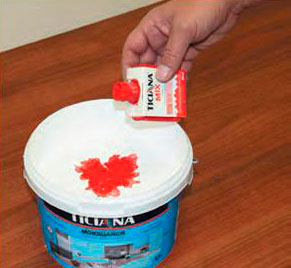
- Prepare several small plastic containers.
- Before coloring acrylic paint, get the same color scheme of the color you need.
- Pour about 100 ml of base into a container and record its exact volume.
- Add a few drops of one dye or several (if you need a complex shade). Write down the number of drops as well as the color data.
- Mix the base and color until a uniform tone is obtained.
Note! An important tip on how to properly tint paint. Start the process with two drops. If the tone seems pale to you, gradually add the dye, but only one drop at a time.
- Once you're satisfied with the color (bear in mind it will look brighter on the base), paint a small area of the surface. When the finish is dry, evaluate the color of the coating under artificial and natural light.
- If the result pleased you, you can.
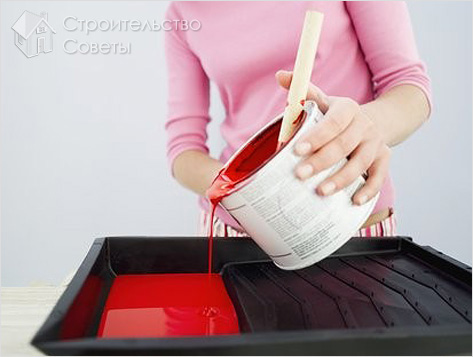
- Subtract 20% from the required amount of color without fail. This is necessary so that the final tone of the coating matches the one you need. Colors on a large area always look brighter than on a small one.
Our example is Zinga conductive paint. To obtain its desired color, 5 drops of color should be added to 100 ml of the base.
If you follow the logical chain, then 50 drops are needed for 1 liter. However, in reality, 40 drops of color should be added to such a volume.
Conclusion
We figured out how to make paint tinting in the best way. If you choose the manual method, you can create a unique shade of the coating. Preferring the computer method, you will be spared quite likely errors ().
The video in this article will complement the information provided to you.




















